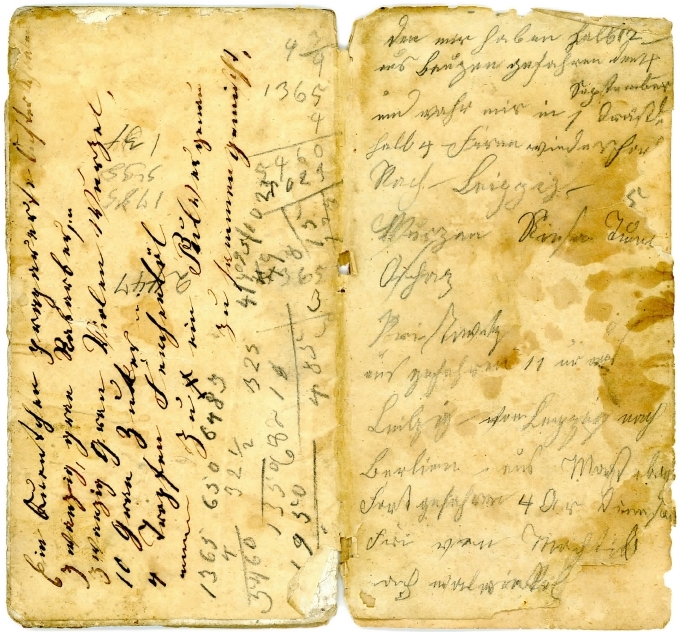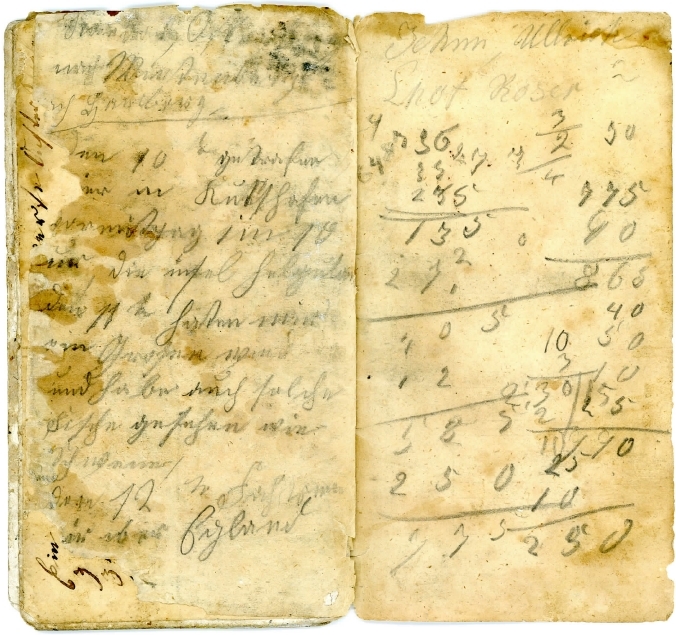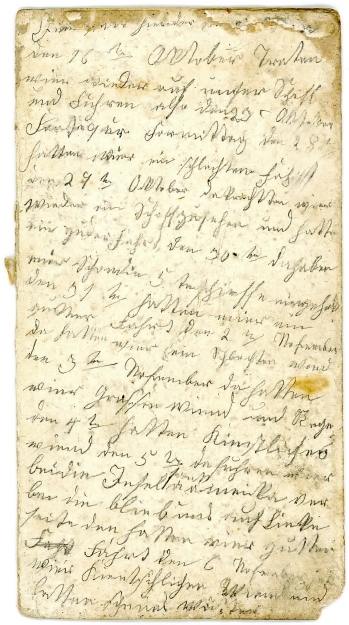mersiowsky
|
|
Johann Kieschnick's Ben Nevis Diary
This article by Marilyn Luce Miertschin Nickelsburg first appeared in the Texas Wendish Heritage Society
Newsletter of April 2016, pages 9-11.
Another Account of the 1854 Migration
Until now we had only four accounts of the 1854 migration written by individuals who were participants. Pastor Johann Kilian left his collection of a
diary, letters, and notes. (See the TWHS Newsletter of October 2012 “Death on the Irish Sea”) A German, August Haak, also wrote an account of his experience, which Dr. Joseph Wilson edited and which was subsequently
published in the Journal of the German-Texas Heritage Society. A third source of information was a letter written by Johann Sommer also later printed in the January 2002 issue of the TWHS Newsletter. And the fourth is a letter (Ein Brief) written by Johann Teinert many years after the actual voyage. Now, thanks to the work of Marilyn Luce Miertschin Nickelsburg we have a
fifth source—an account written by Johann Kieschnick.
Marilyn Nickelsburg traces her Wendish ties to the Kieschnick and Miertschin families, and has done extensive work on the Miertschin family. A fourth
generation Wend, she was born in Texas (Ft. Worth) but lived in other states—separated from Wendish connections. She married George W. Nickelsburg, a
pastor who became a professor of religious studies at the University of Iowa. They are now retired and reside in Washington. George Nielsen
Johann Kieschnick’s 1854 Travel Diary
By
Marilyn Luce Miertschin Nickelsburg
Finding An Ancestral Diary
Questions? Questions? Questions? My genealogy generates a mountain of questions I wish I could ask the people on my family tree. What was your life
like? How and why did you come to live where you did? What major events happened during your life? What is the one thing you would like your
descendants to know about you?
I consulted some historical resources, but I did not find anything that revealed their personal feelings and experiences. When I began to research my
family history, I had a few facts, some names, and some sense of the places where they had lived. I learned that while my paternal side came from
Germany, they had a special designation—“the Wends.” As I delved deeper into the facts and even began to visit the homeland of my ancestors, I came to
understand that “Wends” was a term that Germans applied to outsiders of Slavic origin. In point of fact, some of the “Wends” in Germany have returned
to their tribal name and they now refer to themselves as Sorbs.
In 1952, when I was visiting my grandmother (Grossmama) in Thorndale, Texas for three weeks, I discovered a cache of photographs of couples dressed in
nineteenth century wedding attire. Along with the photos, I found a small worn and battered brown leather diary. When I asked Grossmama who these
people were and whose diary this was, she answered, “This was your Grandfather’s.” She then identified the people in the photographs. When I asked if
I could have the photos and the diary, she said, “Yes.” The discovery of these items sparked my broader interest in history and began the journey of
tracing my ancestors.
I wonder why Grossmama kept those photographs and the diary. Was she the unofficial “family historian” and did she sense in me that I would take on
such a role in our family?
I have other memories of Grossmama and her house in Thorndale where I learned about life in a rural community, but it was this conversation about the
people in the photographs that made me feel connected to a larger family—people I didn’t know but wanted to. With the gift of these family artifacts,
I was linked to another generation and to an unknown nineteenth century travel adventure that I would never experience.
At the time, I didn’t think about the diary and simply put it away. Years later, when I became more interested in my family, I realized that the diary
could not have belonged to my Grandfather, as Grossmama had said. He had been born in the United States, but the diary, written in German, described a
trip to the United States. Was the diary her grandfather’s or her father’s? Both had immigrated with the Wendish group in 1854. Because of the
youthful wonderment expressed in the writing, I concluded the author was her father, Johann Ludwig Kieschnick—my great grandfather—the man whom
Grossmama called “Grandfather.”
The Diary’s Author
Johann Kieschnick was twenty years old when he began the trip in September 1854 from his home near Bautzen in the kingdom of Saxony. He traveled with
his family: his father (Johann); his mother (Agnes); three of his four sisters (Magdalena, Maria [his twin], and Agnes); and his older brother
(Andreas). During the voyage, a sizeable number of Wendish people died and his father took in some of the children from the Miertschin family, who had
lost their parents.

Johann Ludwig Kieschnick
Johann Kieschnick married Pauline Bartel, a German, in 1858. Grossmama, Dorothea Agnes Auguste, born in 1877, was the ninth of their eleven children.
Johann served in Waul’s Texas Legion during the Civil War, first in the infantry and then, after an illness, as a shoemaker. In the U.S. Censuses of
1870, 1880, and 1900, he lists his profession as farmer He also built houses in Brenham. The Johann Kieschnick family lived in Brenham, Lincoln, and
Thorndale, and it was in Thorndale where Dorothea Augusta married my grandfather, Ernst Adolph Miertschin, in 1895. Johann died there in 1916.
Physical Description of the Diary
Examining the contents within the shabby leather covers of my ancestor’s diary, I catch glimpses into the world of nineteenth century German
travelers. Probably purchased along the way, this travel diary contained paper on which to record one’s trip, useful travel aids, and illustrations
that stimulated one’s imagination about what might occur during one’s trip.
The old brown leather cover lined with blue paper measures 4” x 14/16”. When one opens the leather cover,
one sees two black and white illustrations on the inside of the front and back covers: one is titled
“Schiffarth über die Felsen des Jlhéos in Südamerica” (“Boat trip over the rocks of the Ilhéos [River] in South America”), and the back page
is titled
“Kampf zwischen einer Königschlange und einem bengalischen Tiger” (“Battle between a King Snake and a Bengal Tiger”)
Lying loose within the diary covers are three sets of paper, each consisting of two leaves attached to one another. Of these, two sets are of yellowed
paper. The first set contains some traveler’s aids—a perpetual “Kalender” and “Wasch Tabelle” (laundry list). On the reverse side of these two leaves
are some calculations and the names of two men (Johan Ullrich and Chof Roser). The second set of yellowed paper pages contains on one leaf a home
remedy recipe in brown ink and some more scrawled numbers. Inscribed in pencil, the two sides of the attached second leaf (identified as A.1 and A.2
in the translation below) recount the beginning of his travel narrative—by rail from Bautzen to Cuxhaven and then by ship to England.

A.1

A.2 (Reverse of A.1)
The third set of two attached leaves of whitish cardboard-like paper (identified as B.1, B.2, B.3, and B.4 in the translated narrative) contain the
rest of the preserved narrative. Inscribed in pencil on both sides, this portion of the narrative is four pages in length.

B.1

B.2 (Reverse of B.1) and B.3

B.4 (Reverse of B.3)
Some tiny fragments attached to B.1 and 4 indicate that some pages before and after this set have been lost. A comparison of the six pages of his
travel diary with the actual journey indicates that five weeks of narrative are missing. These missing pages would have recounted the journey from the
arrival in England around the 12th of September (the end of A.2), through the cholera epidemic that struck some of the passengers, until the 16th of
October (the beginning of B.1) when the group boards the ship that leaves Queenstown a week later.
The Translation
For over fifty years, I had continued to be curious about this diary. Eventually my husband contacted a person at Brigham Young University in Provo,
Utah, who agreed to translate the few pages. Once translated, the arrangement of the pages fell into order.
The diary reveals the adventure of a young man—one who has lived in a land-locked agricultural area and has never traveled. Progress is marked in
days, hours, and miles, and by the places he passes. Perceptions of the natural world concentrate on varying weather conditions, unusual land features
like islands, and peculiar fish, which he compares to pigs. Fascinated by the ship, he notes its speed and the number of its sails. The vastness of
the ocean is suggested by his occasional remarks about an island or a passing ship. His narrative is not concerned with named people, but reflects his
experience of the new and intriguing world that is unfolding before him.
Diary Text
A.1. Then we left Bauzen (Bautzen) at 11:30 on 4 September (Monday) and we were at 1:00 in Dresden. At 3:30 we left again for Leipzig.
Wurzen, Riesa, [...], Oschatz, Priestwitz (Priestewitz)
(We) left Leipzig at 11:00 toward Berlin. From Machteburg (Magdeburg) (we) set out at 4:00 Tuesday, early from Machtib[burg] toward
<Mahl>winkel (Diary text: Walwinkel) [...].
2. Stendal, Oste[rburg] to Wietenberge (Wittenberge) to Hamburg.
On the 10th we arrived in Kukshafen (Cuxhaven). The10th in the morning (we saw/passed) the island of Helgoland (Engl. Heligoland). On the 11th we had
a strong wind and (we) saw fish that looked like pigs. On the 12th we traveled across England (text: fuhren [w]ir iber Egland).
B.1. [top line obscured by attached fragment]. On the 16th of October (at Queenstown) we went aboard our ship again and sailed off on the 23rd of
October at 9 o’clock in the morning. On the 28th we had bad sailing. On the 29th of October, there we got to see another ship and had good sailing. On
the 30th we had already caught up with five ships. On the 31st we had good sailing. On the 2nd of November we had a bad wind. On the 3rd of November,
there we had a strong wind and rain. On the 4th (we) had favorable wind. On the 5th we sailed past the Island Sankan Meika (São Miguel), which lay to
our left. Then we had good sailing. On the 6th of November we had favorable wind and had beautiful weather.
2. On 7th of November, there we had a very good wind and there we put up 25 sails. On the 8th we had a quite favorable wind. From the 10th to the 12th
of November we had a favorable wind. On the 10th we saw the first flying fish, but they were small. From the 12th to the 15th we had continuous good
wind. On the 16th of November we saw a few ships. Until the 21st we had good sailing. On the 22nd we sailed past three islands. The 1st (was)
Diesidere (Desirade). The 2nd (was) Cuadulupe (Guadalupe). The 3rd (was) Manzära (Montserrat). (We) sailed very close by the edge of the Island of
Mandzära. It was the 23nd at 10 o’clock in the evening when we were all up on the deck. On the 23rd to the 25th we didn’t (have) any strong wind. On
the 26th and the 27th we didn’t have any favorable wind. On the 28th we got to see the island of [… text scuffed].
3. On the 29th and 30th of November, there we had very bad sailing. That was near the island of Dominica. There we were motionless for three days. On
the 1st of December we got a very favorable wind and sailing, so fast that we made thirteen English miles in only fourteen (text: vir-leitzen read as
vierzehn) hours. On the 2nd of December we sailed 25 English miles in 24 hours. On the 3rd we didn’t have any strong wind. We didn’t get to see the
island of Cuba because the wind was against us.
4. [… hidden under attached fragment: On the 4th] of December, there we saw the last tip of the island of Cuba. We also saw two warships loaded with
cannon and guarding the island. On the 8th of December we had a big storm and rain. On the 13th we got to see Galveston. On the 14th, there we saw the
city. At 4 o’clock in the afternoon, there a steamship picked us up. On the 15th we disembarked in Galveston and stayed there for 1 and ½ days. Then
we traveled to Houston. We st[ayed] there for 4 d[ays].
Here the preserved remnant of his account of the voyage ends. At the beginning, Johann doesn’t mention the reasons why he and his family left Germany.
The lost page or so at the end may have described his journey from Houston to his first home in Texas and his plans for the new world. Nowhere in what
is preserved does he mention his religious faith and his connection to the Lutheranism that he professes the rest of his life.
Having traveled far from my Texas Wendish roots, I reconnected with my origins through the photographs and the diary that Grossmama gave me. After I
visited my great grandfather’s homeland in Saxony, I had an even greater appreciation for the world he left behind. The diary allows me to experience
his trip and to ponder the legacy he left me.
Author’s note
The translation was initially prepared by Prof. Roger P. Minert of Brigham Young University, Provo, Utah, and was revised by George Nickelsburg on the
basis of a transcription by Dr. Karl-Heinz Rehbein of Lüneberg, Germany. Symbols used in the translation: [ ] indicate physical gaps in the text;
<> enclose corrections to the text; ( ) supply words for good English or clarification. My thanks also to George Nielsen for his helpful
suggestions.
|
|
|
Dan Bednarski
Rookie Wendish Poster

Posts: 8
Registered: 11-25-2014
Location: The Twilight Zone
Member Is Offline
|
|
Thank You Marilyn
What a nice nugget of history to share! All family history is meaningful and worthy of recording, and we can be thankful for those who capture such
experiences and make them available to those whom are interested.
Just yesterday, I became aware of an auction that included some old photos of the members of a police department, probably the Lincoln, Texas Police
Department. Pictures may have been from the 1930's or 1940's. And an old photo album of an unknown family. What a sad thing to view. Family history
being discarded in an auction. Who were these people? What were their accomplishments? What were their likes and dislikes? All of them just one step
away from the trash heap.
Again, thank you Marilyn for your efforts, and the work of your family and others to translate and publish this diary.
|
|
|
|